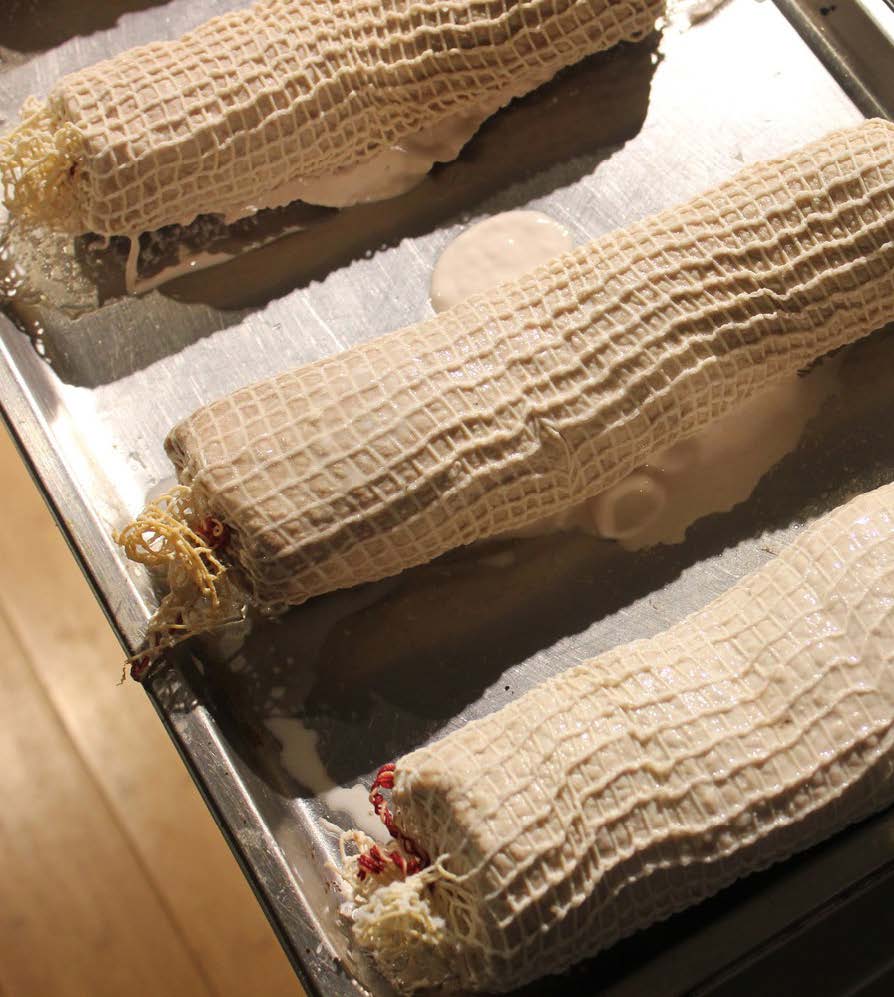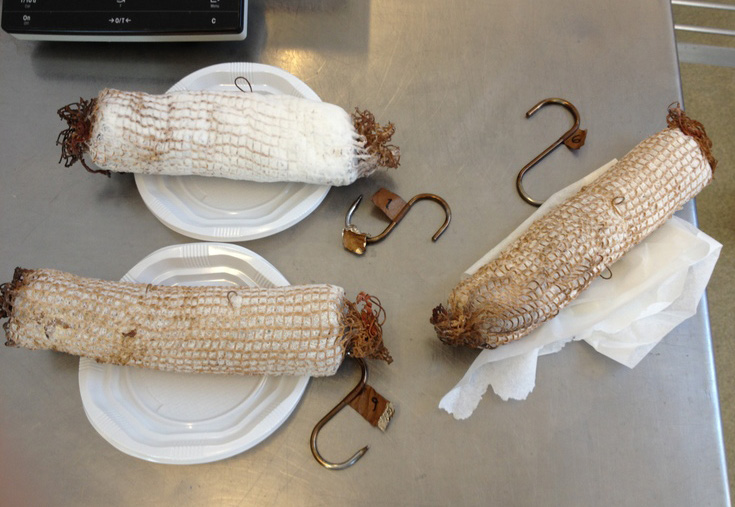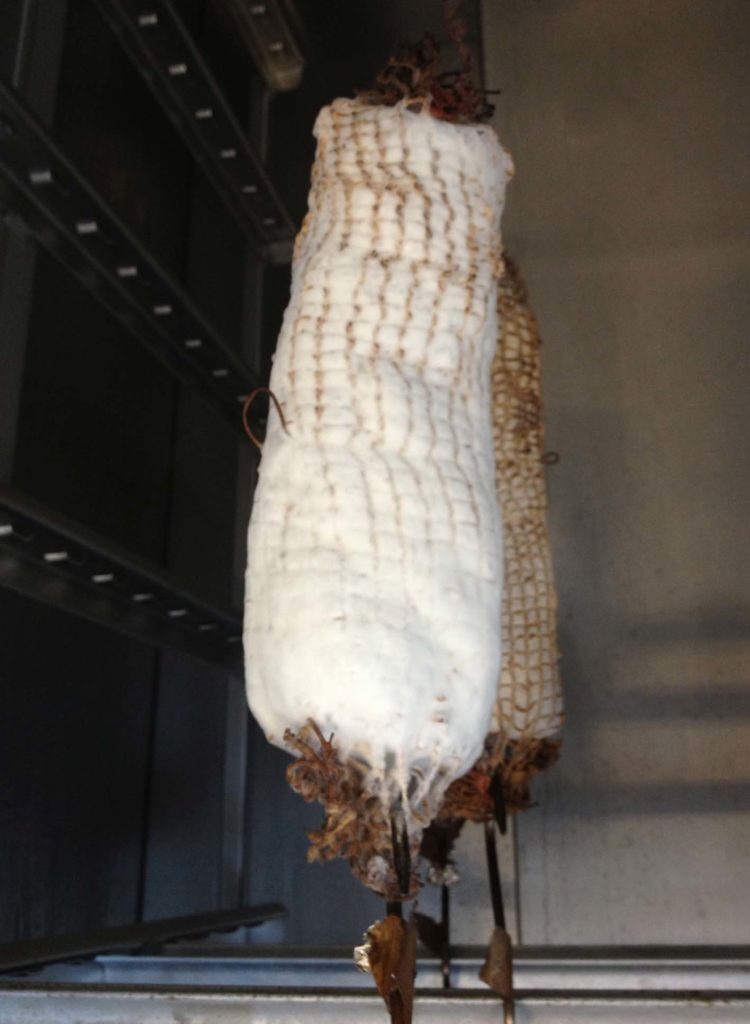posted by Anne Overmark
For the past two months or so I have had the pleasure of playing around with some pork of shady character, a Weber hot smoking grill and some (hopefully) potent microorganisms. My intention with all this? To make a delicious product out of an ingredient many consider repulsively flawed – boar-tainted meat.
It began with the prospect of a voluntary ban on castration of male piglets within the European Union in the year 2018. Castration is a practice primarily performed to prevent boar taint, the unpleasant odour and flavour that may occur in meat from uncastrated males (Lunde et al. 2013), and which is commonly believed to be caused by the two compounds skatole (3-methylindole) and androstenone (5α-androst-16-en-3-on) (Stolzenbach et al. 2009). However, due to animal welfare issues, this practice is
expected to be voluntarily abandoned (Lunde et al 2013 and Font-i-Furnols 2012), which could well lead to an increase in boar-tainted meat that has limited use. There is a resulting interest shared by industry and the consumer to compensate for the off-odours and off-flavours caused by skatole and androstenone and to improve the sensory acceptability of products made of meat from uncastrated male pigs. According to Luckow et al. (2006) masking is one technique that has been used to reduce the perception of aversive odours and flavours in foods through the addition of different flavour compounds to different cuts of pork containing various amounts of skatole (Lunde et al. 2008 ; Stolzenbach et al. 2009 ; Lunde et al. 2013). Nordic Food Lab has undertaken some previous experiments in applying processing methods similar to those used in the production of Katsuobushi to pork. Inspired by this work I will investigate how cooking, drying, smoking, and fermenting will affect the flavour and odour of boar-tainted meat.
Traditionally Katsuobushi, a dried fermented product, is processed from bonito/skipjack tuna (Katsuwonus; Katsuo in Japanese), the processing of which dates back to the Edo period (1603-1868) (Fujita 2009). Today Katsuobushi is processed in two Japanese coastal cities, Tosa and Makurazaki, in which around 70 small family businesses process the fresh bonito into Katsuobushi (Mouritzen and Styrbæk 2011). Katsoubushi is divided into two main categories: Arebushi which is not fermented and Karebushi which is (Mouritzen and Styrbæk 2011). The bonito goes through four steps – cutting, cooking, smoking and drying/fermenting – before it becomes Kastuobushi (McGee 2004, Mouritzen and Styrbæk 2011). At first the bonito is cut into two filets, which are simmered in salted 90⁰C water for about one hour. After cooking the bones and skin are removed. The filets are then smoked in a hot smoker for at least 6 hours for 14 consecutive days, resulting in a product called Arabushi which contains 40% of the original water content and is covered by a tarlike layer (Mouritzen and Styrbæk 2011). Arabushi is used in foods but the filets can also be further processed into the finer and more palatable Karebushi. In the further processing of Karebushi, the tarlike layer is removed and the filets are left to dry in the sun for a few days. To remove even more of the remaining moisture the filets are inoculated with different moulds. The literature is not consistent with regard to exactly which ones, but the species Aspergillus glaucus, Aspergillus melleus, Aspergillus repens, Aspergillus candidus and Pencillium glaucum are all mentioned (Mouritzen and Styrbæk 2011, Hesseltine 1983, Nout 2007), with Aspergillus glaucus mentioned most often. The inoculated filets are placed in a room in which they undergo fermentation for about two weeks (McGee 2004). After two weeks the fish is brought out to dry in the sun for a day or two and the mould is scraped off. This moulding and drying process is repeated several times, and at the end of the processing, which lasts three to five months, the meat will, when struck, “sound like a resonant piece of wood” (McGee 2004).
I started out with 9 pork filets (Longissimus dorsi). Three came from the meat supplier, so it did not contain skatole or androstenone above the threshold values (in pure solutions, .20-.25ppm and .5-1.0ppm respectively (Tørngren 2010)) and the remaining six were selected at the slaughterhouse in Ringsted. The skatole levels (ppm) in the final six were: .34, .34, .37, .50, .52 and .58 (measured in the back fat of the carcass). The filets were stuffed into nets (like those used for hams) then steamed at 100⁰C until a core temperature of 70⁰C was reached.

The filets were then left to dry before they were hot-smoked with wood chips made of apple, mesquite and hickory wood for 4 hours. The smoking was repeated the following day before the filets were left in a cold and dry place for three days. The initial processing steps took place at Nordic Food Lab, while the fermentation and final drying stages are being carried out in a climate-controlled chamber at the Danish Meat Research Institute (DMRI) in Roskilde. As previously mentioned mostly Aspergillus species are used in the traditional processing of Katsuobushi, but due to the constraints of EU food safety regulation the filets were inoculated with Pencillium nalgiovense strains, which are approved to be used on meat intended for consumption. Three packages of freeze-dried spores were supplied by Chr. Hansen and Danisco. The strains are probably very similar with regard to how they will affect the flavour and odour; however I decided to try out all three packages and inoculated three filets with each different strain. The spore solutions were prepared according to the instructions on the packages. I made 1L of each in sterile plastic bags and bathed the filets in their respective inocula. One day prior to inoculation the climate chamber was set to have a relative humidity (RH) of 95%, a temperature of 22⁰C and an air flow of 25% of maximum (It is very important that the spores get optimal conditions, to ensure a fast onset of the fermentation). After inoculation the filets were hung with space between them in the climate-controlled chamber for four days, and when I opened the door after the weekend, a nice white layer had covered them completely. Three of the filets had more fuzz compared to the others, but it was likely a characteristic specific to one strain.
The processing of the boar-tainted meat is at the time of writing in its final, but most time-consuming, step: the drying process. I have lowered the relative humidity by 10% per week, and it is now down to 75%. The temperature is lowered to 15⁰C and I plan to keep it there until it is finished. I have weighed the meat before and after each processing step, to be able to calculate the moisture loss and predict the risk of potential growth of contaminating pathogenic microorganisms, and I certainly hope it is safe to eat as I am very excited to taste the bushi in about a month.
To be continued when new data becomes available.
References:
Fujita, C., 2009: “Dried Bonito”. The Tokoyo Foundation. http://www.tokyofoundation.org/en/topics/japanese-traditional-foods/vol.-15-dried-bonito. Found December 5th 2012.
Hesseltine, C.W., 1983. ” Microbiology of Oriental Fermented Foods”. Ann. Rev. Microbiol. 1983. 37:575
Luckow. T., Sheehan. V., Fitzgerald. G. and Delahunty. C. (2006) Exposure, health information and flavour-masking strategies for improving the sensory quality of probiotic juice. Appetite. Vol 47. pp. 315-323.
Lunde. K., Egelandsdal. B., Choinski. J., Flåtten. A. and Kubberød. E. (2008) Marinating as a technology to shift sensory thresholds in ready-to-eat entire male pork meat. Meat Science. Vol. 80. pp. 1264-1272.
Lunde. K., Skuterud. E., Lindahl. G., Hersleth. M. and Egelandsdal. B. (2013) Consumer acceptability of differently processed bacons using raw materials from entire males. LWT- Food Science and Technology. Vol 51. pp. 205-210.
McGee, H., 2004: “McGee on Food & Cooking an encyclopedia of kitchen science, history and culture”. Hodder and Stoughton
Mouritsen, O.G. and Styrbæk, K., 2011: “ Umami – Gourmetaben & den femte smag”.
Nout, R. M. J., 2007: ” Food Mycology- A multifaceted approach to fungi and food”. Chap. 17. Mycology. Vol. 25. CRC Press.
Stolzenbach, S., Lindahl, G., Lundström, K., Chen, G. and Byrne, D. (2009). Perceptual masking of boar taint in Swedish fermented sausages. Meat Science. Vol. 81. Pp. 580-588.
Tørngren, A.M. (2012). Litteraturstudie- Anvendelse af lugtende hangrisekød. Danish Meat Research Institute. Project nr. 1378600.



